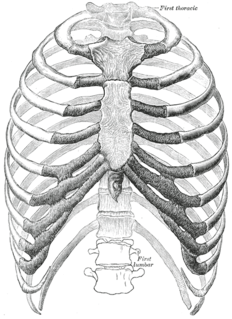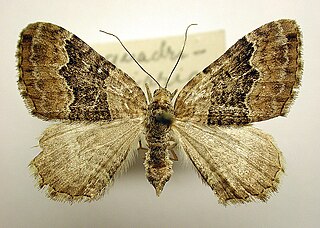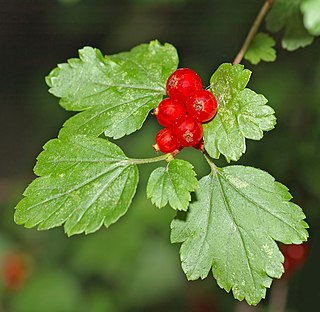
The rib cage is the arrangement of ribs attached to the vertebral column and sternum in the thorax of most vertebrates, that encloses and protects the heart and lungs. In humans, the rib cage, also known as the thoracic cage, is a bony and cartilaginous structure which surrounds the thoracic cavity and supports the shoulder girdle to form the core part of the human skeleton. A typical human rib cage consists of 24 ribs in 12 pairs, the sternum and xiphoid process, the costal cartilages, and the 12 thoracic vertebrae.

The gooseberry, with scientific names Ribes uva-crispa, is a species of Ribes.

The thorax or chest is a part of the anatomy of humans and various other animals located between the neck and the abdomen. The thorax includes the thoracic cavity and the thoracic wall. It contains organs including the heart, lungs, and thymus gland, as well as muscles and various other internal structures. Many diseases may affect the chest, and one of the most common symptoms is chest pain. The word thorax comes from the Greek θώραξ thorax "breastplate, cuirass, corslet" via Latin: thorax.

The common emerald is a moth of the family Geometridae. The species is found throughout the Nearctic and Palearctic regions and the Near East. It is mostly commonly found in the southern half of the British Isles. It was accidentally introduced into southern British Columbia in 1979.

Pork ribs are a cut of pork popular in Western and Asian cuisines. The ribcage of a domestic pig, meat and bones together, is cut into usable pieces, prepared by smoking, grilling, or baking – usually with a sauce, often barbecue – and then served.

Spare ribs are a variety of pork ribs cooked and eaten in various cuisines around the world. They are cut from the lower portion of the pig specifically the belly and breastbone, behind the shoulder, and include 11 to 13 long bones. There is a covering of meat on top of the bones and also between them. Spare ribs (pork) are distinguished from short ribs, which are beef.

In architecture, a vault is a self-supporting arched form, usually of stone or brick, serving to cover a space with a ceiling or roof. The simplest kind of vault is the barrel vault, which is generally semicircular in shape. The barrel vault is a continuous arch, the length being greater than its diameter. As in building an arch, a temporary support is needed while rings of voussoirs are constructed and the rings placed in position. Until the topmost voussoir, the keystone, is positioned, the vault is not self-supporting. Where timber is easily obtained, this temporary support is provided by centering consisting of a framed truss with a semicircular or segmental head, which supports the voussoirs until the ring of the whole arch is completed. With a barrel vault, the centering can then be shifted on to support the next rings.

Eulithis prunata, the phoenix, is a moth of the genus Eulithis in the family Geometridae.

Abraxas grossulariata is a moth of the family Geometridae, native to the Palaearctic ecozone and North America. Its distinctive speckled colouration has given it a common name of magpie moth. The caterpillar is similarly coloured to the adult, and may be found feeding on the leaves of shrubs such as gooseberry and blackcurrant. The species was first described by Carl Linnaeus in his 1758 10th edition of Systema Naturae.

Macaria wauaria, the V-moth, is a moth of the family Geometridae. It has a Holarctic distribution. The species was first described by Carl Linnaeus in his 1758 10th edition of Systema Naturae.

Spoladea recurvalis, the beet webworm moth or Hawaiian beet webworm, is a species of moth of the family Crambidae. It is found worldwide, but mainly in the tropics.

Alucita hexadactyla is a "micromoth" of the many-plumed moth family (Alucitidae). It is found in Europe and has been introduced into North America.

Synanthedon tipuliformis, known as the currant clearwing, is a moth of the family Sesiidae. It is endemic to the Palearctic ecozone, but is an invasive species in the Nearctic ecozone and the Australasia ecozone.

Zophodia grossulariella is a species of moth of the family Pyralidae. It is found in Europe and North America.

Xanthorhoe quadrifasiata, the large twin-spot carpet, is a moth of the family Geometridae. It is found in most of Europe, east to the Near East and the eastern part of the Palearctic ecozone.

Eudemis porphyrana is a moth of the family Tortricidae. It is found in most of Europe, east to the eastern part of the Palearctic ecozone.

The currant shoot borer moth is a species of moth of the family Prodoxidae. It is found in most of central, northern and eastern Europe. It is also found in North America.
Euhyponomeutoides ribesiella is a moth of the family Yponomeutidae. It is found in Fennoscandia, Germany, Poland, Estonia, Ukraine, Slovakia, Austria, Belgium and France.
























